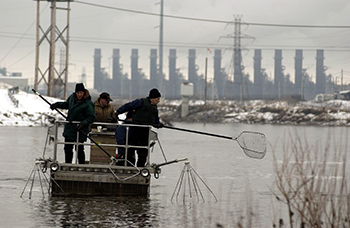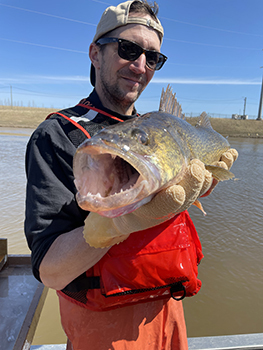Casting for walleye on Saginaw Bay
By JEFF JOLLEY
Southern Lake Huron Management Unit manager, Fisheries Division
Michigan Department of Natural Resources
It’s springtime in Michigan, and cars, trucks and semis race toward Bay City and points north and south from Flint to metro Detroit. Some of those drivers might be heading to sunny shores and boat launches along Lake Huron.

If you find yourself as a passenger in a car traveling over the Zilwaukee Bridge on I-75, which rises over 100 feet above the Saginaw River, look at the surrounding landscape of eastern Michigan. If time allows, look closer. You will see some domed industrial buildings, and mountains of gravel and stone. There might also be some freighters and barges, as well as some smaller boats cruising the river’s mocha-colored water.
If it were possible, an even closer, deeper dive into the water would reveal a multitude of goldish-brown fish forming a ribbon in the distance. Any rays of sunlight able to penetrate the flocculence of the water reflect white off many pairs of fish eyes. It is the mighty walleye, cherished by many as the king fish of the Midwest. They are aptly named for the membrane over their eyes, in Latin called the tapetum lucidum, which reflects and focuses light.
|

Walleye are formidable visual predators in low light conditions. And there are millions of them. They come from Saginaw Bay and farther, from Thunder Bay, from Ontario, from southern Lake Huron. They have come for their annual migration to spawning grounds in the arteries of the Saginaw watershed – the Flint, Cass, Shiawassee and Tittabawassee rivers.
Predators of walleye
What nature giveth, nature taketh away. In the early 20th century, over 1 million pounds of walleye was annually harvested from Saginaw Bay. Then along came the alewife in the 1920s – it was a blessing and a curse.
Alewife invaded the Great Lakes when the Welland Canal opened so ships from the interior Great Lakes could bypass Niagara Falls and get to the Saint Lawrence River, the Atlantic Ocean and beyond. That also opened the door for fishes to swim in and colonize this new habitat.
Alewife fell in love with the Great Lakes, and we fell in love with the alewife. Here was the perfect fish food for the Chinook salmon, the new favorite hard-fighting, fast-growing and delicious-tasting focus of the sport fishery of the Great Lakes.
|

But the curse was that alewife eat baby walleye, and they eat all the things that baby walleye eat. A population explosion of alewife, along with a myriad of other factors, including overfishing and pollution, nearly drove the walleye to extinction.
But new players entered the story, namely zebra mussels and quagga mussels, and fundamentally changed the structure of the food web. These new mussels became the new stationary Roomba of the Great Lakes, and the power was always on. They are incredible at doing their job, which is filtering plankton from the water.
There is an adage among fishery scientists that might apply here: “He who eats the smallest thing, wins.” The alewife lost the food battle with the new mussels, and their population numbers plummeted. Another invader, the round goby, then entered the scene and has become a good alternate prey source for walleye.
Stocking walleye in Saginaw Bay
Attentive fisheries managers had been stocking many walleye into the bay to keep the population on life support over the years in the face of the massive alewife effects. The virtual disappearance of the alewife was what the walleye needed to survive. With their population rebounding, there are more than 5 million adult walleye in Saginaw Bay today, providing tremendous fishing opportunities.
|

The Saginaw Bay, Saginaw River and surrounding watershed have gone through a remarkable recovery. Environmental repair, protections and increased awareness have resulted in vast improvements in the health of the ecosystem. Dams have been removed, enabling walleye to make it to many of their former spawning grounds.
Water quality has improved, and egregious polluters have been dealt with, but the recovery is not complete by any means. There are visible scars of past environmental damage and some current open wounds. The basin is still considered an area of concern by the U.S. Environmental Protection Agency.
The disappearance of the alewife wasn’t enough; the walleye needed these improved environmental conditions, although a great deal of work remains.
Walleye fishing
The Saginaw Bay/River fishery rivals that of any walleye fishery in the state and ranks up there with Lake Erie, the South Dakota impoundments, Dale Hollow, Lake of the Woods and Green Bay.
Today, walleye is the most sought-after fish in Saginaw Bay, owing partly to the great population recovery. The population keeps growing, and strong year-classes continue to be pumped out.
|

The limits are liberal – you can keep eight fish a day if they are 13 inches or larger. This year, for the first time ever, the Saginaw River from Saginaw (specifically the Center Street, or Douglas Schenk, Bridge) downstream to the river mouth is open to walleye harvest year-round!
Formerly the season was closed during about six weeks in March and April to let the walleye move through the river to their spawning grounds.
This is about 22 miles of river fishing for anglers to explore.
While anglers cruise out past the Spark Plug and past Spoils Island, they can smell the water – it smells like warm chalk with clean, fresh air swirled in as different microclimates swirl about.
The tiny, ghostly midges have hatched, and they sprinkle and settle all around you like the delicate ash of a distant fire.
The rod tip twitches, and the line is strummed below, somewhere in the depths of Lake Huron. It is a walleye down there investigating what you have to offer and maybe it will offer itself to you.
Learn more about walleye at Michigan.gov/Walleye and about Michigan fishing at Michigan.gov/Fishing.
|
Check out previous Showcasing the DNR stories in our archive at Michigan.gov/DNRStories. To subscribe to upcoming Showcasing articles, sign up for free email delivery at Michigan.gov/DNREmail.
Note to editors: Contact: John Pepin, Showcasing the DNR series editor, 906-226-1352. Accompanying photos and a text-only version of this story are available below for download. Caption information follows. Credit Michigan Department of Natural Resources, unless otherwise noted.
Text-only version of this story.
Alewife: Shown in the story's main art, alewives are part of the history of walleye in Lake Huron. (U.S. Fish and Wildlife Service photo)
Survey: A survey crew looks for walleye on the Tittabawassee River.
Walleye - 1, Walleye - 2 and Walleye - 3: One of Michigan's most prized gamefish is the walleye.
Zilwaukee Bridge: The I-75 Zilwaukee Bridge over the Saginaw River is shown.
|